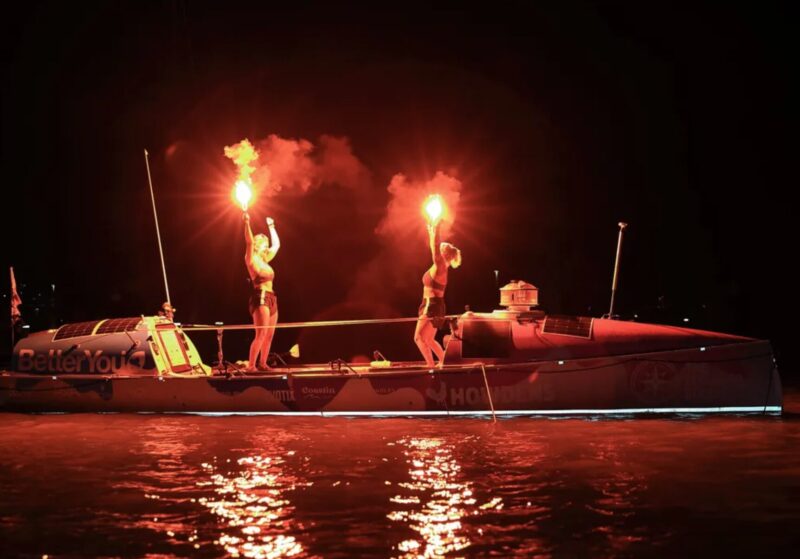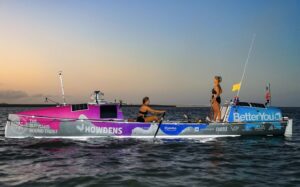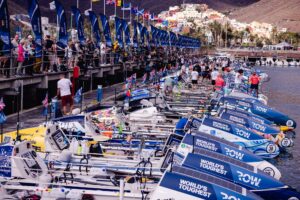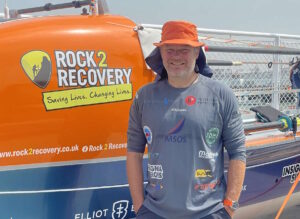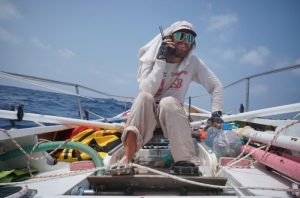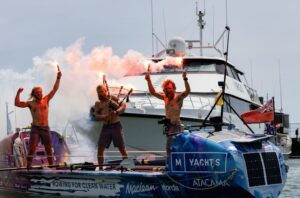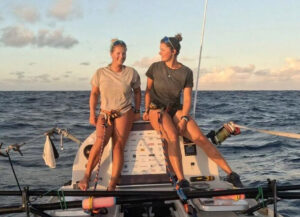Since our last ocean rowing roundup, both crews have set firsts by successfully crossing the Pacific Ocean.
Seas The Day (UK): Miriam Payne and Jess Rowe have become the first women’s team to row nonstop across the Pacific from South America to Australia. After 165 days and 15,210km at sea, they have completed their journey from Lima, Peru, to Cairns, Australia.
From the start, their journey was anything but straightforward. At times, the obstacles they encountered seemed relentless. Only days after launching in April, they had to turn back because of a broken rudder. Not long after they relaunched in early May, the pipes on their water maker burst, and their electrical system was constantly running out of power.
“After nine repairs, we managed a bypass and just limped along with little power for the rest of the crossing,” Payne told the BBC. “Every time something went wrong, we just looked at each other and went, ‘Of course it has!’ But we kept going.”
‘Ghost-ship’ mode
The constant power issues persisted for the rest of the row, despite their best efforts to resolve them. For most of the crossing, they were forced into “ghost-ship” mode. Their batteries were losing power so quickly that they had to switch off all non-essential electronics, including the AIS beacon and chart plotter.
Even with the power issues, the pair managed to row for around 16 hours a day, covering an average of 95km. As with most ocean rowers, the long days were exhausting. Their hands were covered in blisters, and the constant sea spray left them with salt sores. The cabin was so hot that it was nearly impossible to sleep. Despite this, the pair were almost always upbeat, bringing as much fun as they could to the row.
They had initially intended to land in Sydney, but they changed their plans to Brisbane, a less busy location. However, they changed their plan again because of headwinds. Even with the change, the last section of the row in the Coral Sea was tricky. The wind was pushing them southeast, so they had to work hard to keep south, making sure they did not get blown over to Papua New Guinea. Waves crashed over them, worsening their salt sores, and the hot temperatures left them with prickly heat. It was a pretty uncomfortable few days.
Heavy traffic
Off the east coast of Australia, the challenges continued, this time in the form of busy shipping lanes and coral reefs. One big positive was that the ozone over Australia is a little thinner, and their batteries managed to charge more, allowing them to turn their chart plotter back on.
Although they only did this intermittently, it was a significant boost, especially when navigating coral reefs. The pair had planned a good route across the Great Barrier Reef, aided by a local fisherman who was on standby to help guide them if needed. Though it was made harder by crossing it at night, they crossed successfully.
After landing in Cairns, Rowe said, “Those final few hours were brutal. The wind was pushing us off the channel, and we honestly thought we weren’t going to make it. We ended up outside the channel and thought we might have to swim to shore. To finally be here, after talking about it for so long, just feels incredible.”
Margot’s challenges
Louis Margot (CH): Louis Margot is the first Swiss rower to cross the Pacific Ocean. On October 16, he landed on Waigeo Island after 254 days and 17,718km at sea.
He started his cycling and rowing world circumnavigation just over two years ago. He began by biking from Switzerland to Portugal, then rowed across the Atlantic to Colombia. From there, he cycled to Peru to begin his second rowing stage. The row hasn’t been entirely continuous. He paused for several months on Hiva Oa in the Marquesas Islands to repair his boat, replenish supplies, and rest. He set off again on June 1.
This section has been the hardest of the entire journey so far. He has had issues with solar panels and his navigation system, but the hardest part has been the seemingly endless isolation. Pushing into Indonesian waters at the end of September and seeing more boats and local fishermen was a huge boost, even though they didn’t speak the same language.
The difficulty of rowing alone
Near shore, the currents became more changeable, so that almost as soon as he stopped rowing, the boat began moving in a different direction. Once again, highlighting the difficulty of rowing alone, there was no one to take over when he rested. Even with the anchor to try to stop the boat from moving, it was impossible not to lose some ground.
He initially wanted to land in Bali, but after much deliberation, landed on Waigeo Island, part of the Indonesian archipelago.
“It’s not an easy decision, but I’ve learned to listen to my body and accept when it needs [relief],” he said on social media. “The currents are not in my favor, and continuing in these conditions would be risky. “
Getting to land was much trickier than expected. With just 200m to go, his anchors got stuck on rocks on the seabed. He was unable to dislodge them himself, but some local divers came to help free him. Then he sat there, waiting for his visa and the paperwork needed to set foot on the island. This took a few days, but finally he stepped ashore onto dry land.
“I’m immensely proud of it, even if I’ve had a hell of a hard time,” he told the media. “I didn’t think it could be this hard.
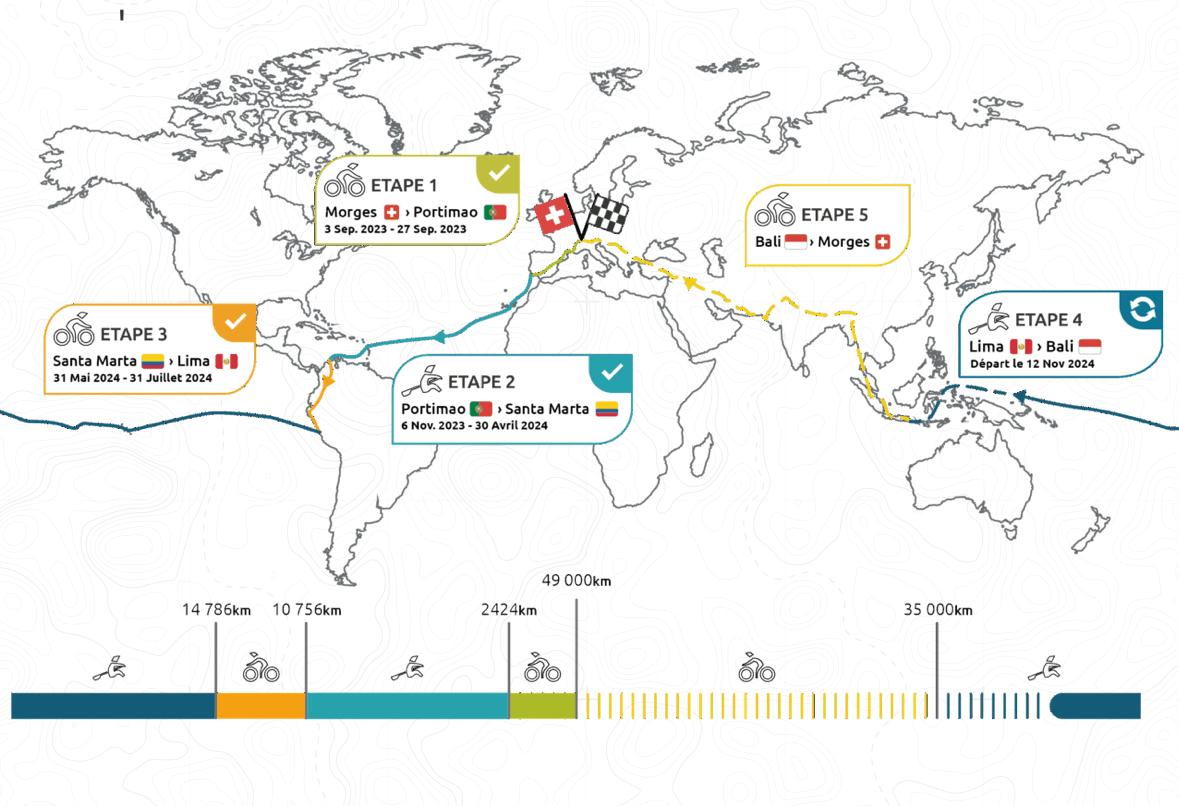
Margot’s general route.
His planned route going forward remains somewhat unclear. “There are several possible options, and each has its advantages and risks. I have to think about all this with my team and experts.”
In general, he will rest for a few weeks, then continue to Bali. After that, he has the small task of cycling and rowing back to Switzerland.
